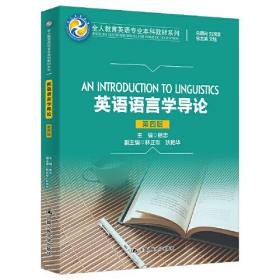
英语语言学导论(第3版)
¥ 8.3 2.5折 ¥ 32.8 八五品
仅1件
湖北咸宁
认证卖家担保交易快速发货售后保障
作者杨忠
出版社中国人民大学出版社有限公司
ISBN9787300250069
出版时间2017-10
装帧其他
开本16开
定价32.8元
货号9787300250069
上书时间2024-09-20
- 在售商品 暂无
- 平均发货时间 15小时
- 好评率 暂无
- 最新上架
商品详情
- 品相描述:八五品
- 商品描述
-
作者简介
杨忠,中国有名语言学家。中国高校功能语法研究会副会长、吉林省社会科学联合会副、吉林教育靠前交流协会副会长、吉林省翻译协会常务副、上海外语教育出版社特邀编审。东北师范大学哲学社会科学学术委员会主任委员,学位委员会副,教授(博士生导师),1993年起享受国务院政府特殊津贴。
目录
4.5.3 Other types of English word formation
Chapter 5 Syntax: The Analysis of Sentence Structure
5.1 Grammaticality
5.2 Knowledge of sentence structure
5.3 Different approaches to syntax
5.4 Transformational-generative grammar
5.4.1 The goal of a TG grammar
5.4.2 Syntactic categories
5.4.3 Phrase structure rules
5.4.4 Tree diagrams
5.4.5 Recursion and the infinitude of language
5.4.6 Subcategorization of the lexicon
5.4.7 Transformational rules
5.5 Systemic-functional grammar
5.5.1 Two perspectives of syntactic analysis: chain and choice
5.5.2 The three metafunctions
5.5.3 Transitivity: syntactic structure as representation of experience
5.5.4 Mood and modality: syntactic structure as representation of interaction.
5.5.5 Theme and rheme: syntactic structure as organization of message
Chapter 6 Semantics: The Analysis of Meaning
6.1 The study of meaning
6.2 Reference and sense
6.2.1 Reference
6.2.2 Sense
6.3 Classification of lexical meanings
6.3.1 Referential meaning and associative meaning
6.3.2 Types of associative meaning
6.4 Lexical sense relations
6.4.1 Synonymy
6.4.2 Antonymy
6.4.3 Homonymy
6.4.4 Polysemy
6.4.5 Hyponymy
6.4.6 Meronymy
6.5 Describing lexical meaning: componential ~nalysis
6.6 Words and concepts
6.6.1 Categorization
6.6.2 Prototypes
6.6.3 Hierarchies
6.7 Semantic relations of sentences
6.8 Metaphors
6.8.1 From rhetorical device to cognitive device
6.8.2 The components of metaphors
6.8.3 Features of metaphors
6.9 Metonymy
6.9.1 Conceptual metonymy
6.9.2 Types of metonymy
6.9.3 Relation between metaphor and metonymy
Chapter 7 Pragmatics: The Analysis of Meaning in Context
7.1 Pragmatics: an overview
内容摘要
。。。
精彩内容
。。。
相关推荐
— 没有更多了 —


















以下为对购买帮助不大的评价